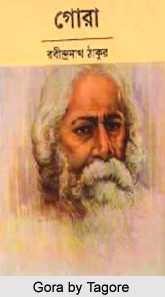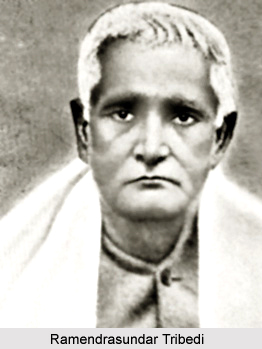 One of the most popular writers of the time was Sarat Chandra Chatterjee whose works have been translated into different languages and continue to be popularly read even today. He was the one who first introduced realism in literature showcasing exploited, abandoned and deprived people exposing the hollowness and ruthlessness of a society based on caste prejudices religious bigotry and opportunism. Bengali prose in the early twentieth century saw a lot of thought-provoking work written by the writers of the time. Among them was Ramendrasundar Tribedi (1864-1919), a professor of science, who was one of the most revered essayists of his time, considered second to none but Rabindranath Tagore, the greatest Bengali literary figure. His extensive range of learning and knowledge, from science, to religion, to philosophy, to linguistics, set him apart from his contemporaries. His major works include Prakriti (Nature, 1896), Jijnasa (Query, 1903), Karmakatha (Talks on Karma, 1913), and Sabaakatha (Talks on the Word, 1917). Tagore`s initial hesitancy of his inconsistency was overcome by his self chosen path by the dint of Chokher Bali (Eyesore, 1903) the first ever psychological novel in Bengali. However, it is Gora which is set against the backdrop of Hindu-Bramho religious rivalry during the Colonial reign that reinforces the greatness of Tagore for ages to come. Gora is an Irishman by birth, but until he realises he lives like an orthodox Hindu emerged in rituals and castes ultimately realising the difference in caste creed and religion.
One of the most popular writers of the time was Sarat Chandra Chatterjee whose works have been translated into different languages and continue to be popularly read even today. He was the one who first introduced realism in literature showcasing exploited, abandoned and deprived people exposing the hollowness and ruthlessness of a society based on caste prejudices religious bigotry and opportunism. Bengali prose in the early twentieth century saw a lot of thought-provoking work written by the writers of the time. Among them was Ramendrasundar Tribedi (1864-1919), a professor of science, who was one of the most revered essayists of his time, considered second to none but Rabindranath Tagore, the greatest Bengali literary figure. His extensive range of learning and knowledge, from science, to religion, to philosophy, to linguistics, set him apart from his contemporaries. His major works include Prakriti (Nature, 1896), Jijnasa (Query, 1903), Karmakatha (Talks on Karma, 1913), and Sabaakatha (Talks on the Word, 1917). Tagore`s initial hesitancy of his inconsistency was overcome by his self chosen path by the dint of Chokher Bali (Eyesore, 1903) the first ever psychological novel in Bengali. However, it is Gora which is set against the backdrop of Hindu-Bramho religious rivalry during the Colonial reign that reinforces the greatness of Tagore for ages to come. Gora is an Irishman by birth, but until he realises he lives like an orthodox Hindu emerged in rituals and castes ultimately realising the difference in caste creed and religion.
Aksaykumar Maitreya (1861-1930) was a lawyer who doubled as a historian and contributed to Sadhana, the journal Rabindranath edited. His important works include Siraj-ud-daula (1897), Mir Qasim (1904), and Phiringi Banik (The European Merchants, 1922). The most important prose writer, after Rabindranath, during this period, however, was Prabhat Kumar Mukhopadhyaya (1873-1932). He, too, was a lawyer who doubled as a writer. Under Rabindranath`s encouragement, Mukhopadhay produced some of the best short stories that Bengali language has ever known. They are characterized by an acute sense of observation and an uncanny sense of humour. Among his major works are Nabakatha (New Tales, 1900), Galpanjali (Story Offerings, 1913), and Jamata Babaji (Dear Son-in-Law, 1931). Prabhat Kumar Mukhopadhay also wrote some novels. Among them the best one is Ratnadip (The Jeweled Lamp, 1915).
 The twentieth century also witnessed the rise of one of the most loved novelists in Bengali literature, Sarat Chandra Chatterjee (1876-1938). He had started writing in 1903 but was not noticed until 1913, when he started writing regularly for periodicals like the Jamuna, Sahitya, and Bharatbarsa. Drawing from his own experience, which was rich and varied, Sarat Chandra wrote from the layperson`s point of view, with no literary pretensions; and although he wrote in the formal Bengali language (sadhu-bhasa), his prose was pedestrian and addressed his readers directly. As a result, his writing stands out, not so much for literary polish but for its genuine warmth of understanding and touching realism. The persistent theme underlying almost all his novels is a deep and sincere sympathy for women and their inhuman exploitation in a patriarchal society. Consequently, we meet several female characters in Sarat Chandra`s novels who have shaken off social bondage, choosing the hazardous life of the outcast instead. Through his writing, Sarat Chandra was responding to the rising consciousness of women`s rights in his own society and forwarding the cause by participating in creating a base of public opinion in favour of suffering Bengali women. It can be said that Sarat Chandra was almost like a social thinker and political activist in his zeal for advancing women`s rights.
The twentieth century also witnessed the rise of one of the most loved novelists in Bengali literature, Sarat Chandra Chatterjee (1876-1938). He had started writing in 1903 but was not noticed until 1913, when he started writing regularly for periodicals like the Jamuna, Sahitya, and Bharatbarsa. Drawing from his own experience, which was rich and varied, Sarat Chandra wrote from the layperson`s point of view, with no literary pretensions; and although he wrote in the formal Bengali language (sadhu-bhasa), his prose was pedestrian and addressed his readers directly. As a result, his writing stands out, not so much for literary polish but for its genuine warmth of understanding and touching realism. The persistent theme underlying almost all his novels is a deep and sincere sympathy for women and their inhuman exploitation in a patriarchal society. Consequently, we meet several female characters in Sarat Chandra`s novels who have shaken off social bondage, choosing the hazardous life of the outcast instead. Through his writing, Sarat Chandra was responding to the rising consciousness of women`s rights in his own society and forwarding the cause by participating in creating a base of public opinion in favour of suffering Bengali women. It can be said that Sarat Chandra was almost like a social thinker and political activist in his zeal for advancing women`s rights.
Even though Sarat Chandra is primarily known for his novels, he has also written a number of short stories. Two of his best-known short stories are Mahesh and Abhagir Swarga. Sarat Chandra`s works continue to be read even today by the Bengali reading public with the same enthusiasm with which they were first received. Prolific as he was, his best novels include Debdas (written 1901, published 1917), Bindur Chele (Bindu`s Son, 1913), Ramer Sumati (Ram`s Return to Sanity, 1914), Parineeta (The Married Girl, 1914), Biraj Bau (Mrs. Biraj, 1914), Pally Samaj (The Village Commune, 1916), Srikanta (4 volumes, 1917, 1918, 1927, 1933), Swami (The Husband, 1918), Grihadaha (Burning the Home, 1919), Dena Paona (Debts and Demands, 1923), and Pather Dabi (The Demand of the Road, 1926). The last mentioned however, was strikingly different from the rest of Sarat Chandra`s corpus since its content was directly political, as a result of which it was proscribed by the British administration soon after publication. Almost all of Sarat Chandra`s novels have been staged, made into movies and television series, and translated into almost all Indian languages. However, his overt emotionalism, which spilled very often into the area of sentimentalism, has prevented Sarat Chandra Chatterjee`s works from winning sustained popularity in the West. In fact, some literary scholars have proposed, albeit arguably, that the innately Bengali character of his writing has prevented Sarat Chandra`s works from being successfully translated into English and other European languages.
There were a number of novelists who followed in Sarat Chandra`s footsteps. Noted among them was Nirupama Debi (1883-1951), a noted woman novelist, whose collection of short stories Aleya (Will O` the Wisp, 1917) and more than a dozen novels secured her a place in the upper ranks of Bengali novelists. The very first novel she wrote, Annapurnar Mandir (Annapurna`s Temple, 1913), remains her best-known work. Her other important work, Syamali (1919), about the awakening of a mentally challenged girl, was later turned into a stage play that received wide commercial success. The other woman novelist who cut ripples of controversy at around the same time was Sailabala Ghosjaya (1894-1973), who, like Nirupama, was also doubling as a short story writer and novelist. She was a daring writer and braved subjects like inter-religious relationships. Her first novel, Sekh Andu (serialized 1915-17), was about the love between an educated Hindu girl and the Muslim chauffeur of her father. Sailabala went on to publish several collections of short stories and some 24 novels.
Thus, the twentieth century produced a number of important literary works which are remembered and enjoyed even today. It may be mentioned here that a number of works have also been adapted on the large screen such as Sarat Chandra`s Debdas.













